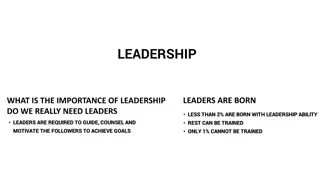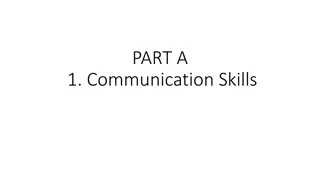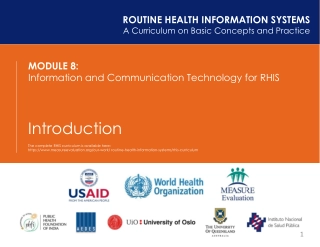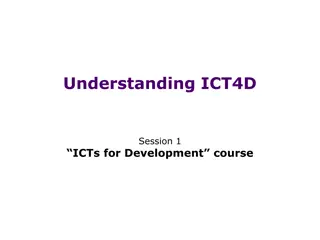Understanding Leadership and Communication in Information Systems
Leadership in information systems involves guiding, influencing, and inspiring individuals towards common goals, while effective communication is essential for exchanging information and ideas. Qualities like vision, collaboration, and empathy make leaders successful. Different leadership styles such as autocratic, democratic, and transformational play a role in shaping organizational dynamics, and clear communication strategies like active listening are crucial in the field of information systems.
Download Presentation
Please find below an Image/Link to download the presentation.
The content on the website is provided AS IS for your information and personal use only. It may not be sold, licensed, or shared on other websites without obtaining consent from the author. Download presentation by click this link. If you encounter any issues during the download, it is possible that the publisher has removed the file from their server.
Presentation Transcript
What did we learn in the last meeting? Do you have a small task to do or something to read/study?
What does "leadership" mean to you in the context of information systems?
LEADERSHIP AND COMMUNICATION
DEFINITION Leadership is the ability to guide, influence, and inspire individuals or a group towards achieving common goals and objectives Communication is the process of exchanging information, ideas, thoughts, and feelings between individuals or groups
What qualities do you think make a leader effective in the field of information systems?
Leadership Styles Autocratic Leadership: This style involves a leader who makes decisions without input from others. Example: In a military operation, a commanding officer gives orders that must be followed without question. Democratic Leadership: This style involves leaders who encourage input from team members and make decisions collectively. Example: A group of scientists collaboratively decides on research methods and experimental designs. Transformational Leadership: Transformational leaders inspire and motivate their teams by setting a compelling vision and leading by example. Example: Steve Jobs transformed Apple Inc. by envisioning products like the iPhone and driving innovation.
Leadership Styles Transactional Leadership: Transactional leaders focus on setting clear expectations, rewarding good performance, and punishing poor performance. Example: A sales manager rewards top-performing salespeople with bonuses for meeting or exceeding sales targets. Servant Leadership: Servant leaders prioritize the well-being and development of their team members. Example: Martin Luther King Jr. championed civil rights by serving and empowering marginalized communities.
Why is clear communication important in the field of information systems?
Communication Strategies Active Listening: Paying full attention to what others are saying, asking clarifying questions, and showing empathy. Example: During a conflict resolution discussion, a manager listens carefully to both sides to find a fair resolution. Clear and Concise Messaging: Using simple and understandable language to convey messages and avoiding jargon. Example: A CEO sends a clear email outlining the company's new strategic goals and objectives. Open and Honest Communication: Being transparent and truthful with team members, especially in difficult situations. Example: A team leader communicates openly about the challenges faced by the project and the steps being taken to overcome them.
Communication Strategies Adaptability: Tailoring communication styles to suit the preferences and needs of different team members. Example: A manager communicates differently with team members who prefer face-to- face meetings, while others prefer email or chat. Feedback: Providing constructive feedback and encouraging open dialogue within the team. Example: After a team presentation, a manager offers specific feedback on the strengths and areas for improvement.
What are some potential challenges leaders might face when leading IT teams, and how can they address them?
MIS in Leadership and Communication Facilitating Data-Driven Decision Making: Leaders can use MIS to access relevant data and information to make informed decisions. Example: A marketing manager uses data analytics software to analyze customer behavior and optimize marketing strategies. Facilitating Improving Communication: MIS tools such as email, video conferencing, and collaboration platforms enhance communication within and between teams. Example: A project manager uses a collaboration platform like Slack to facilitate real-time communication among remote team members. Improving
MIS in Leadership and Communication Monitoring Performance: Leaders can use MIS to track team performance, identify trends, and make necessary adjustments. Example: A school principal uses MIS to monitor student attendance, test scores, and teacher performance to improve educational outcomes. Monitoring Enhancing Information Security: MIS helps in securing sensitive information, which is vital for maintaining trust in leadership. Example: A hospital employs a robust MIS system to protect patient records and comply with healthcare privacy regulations. Enhancing
Can you think of a simple way leaders can motivate their teams in the technology field?

















































